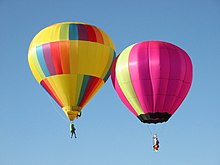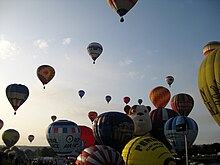I am working on the modern balloons and records section and Theory Section Currently
Modern balloons edit




Modern hot air balloons, with an onboard heat source, were developed by Ed Yost and Jim Winker, beginning during the 1950s; their work resulted in his a first successful flight on October 22, 1960.[1] The first modern hot air balloon to be made in the United Kingdom (UK) was the Bristol Belle, built in 1967. Presently, hot air balloons are used primarily for recreation.
Records edit
Hot air balloons are able to fly to extremely high altitudes. On November 26, 2005 Vijaypat Singhania set the world altitude record for highest hot air balloon flight, reaching 21,027 m (68,986 ft). He took off from downtown Mumbai, India, and landed 240 km (150 mi) south in Panchale.[2] The previous record of 19,811 m (64,997 ft) had been set by Per Lindstrand on June 6, 1988, in Plano, Texas.
On January 15, 1991, the Virgin Pacific Flyer balloon completed the longest flight in a hot air balloon, when Per Lindstrand (born in Sweden, but resident in the UK) and Richard Branson of the UK flew 7,671.91 km (4,767.10 mi) from Japan to Northern Canada. With a volume of 74,000 cubic meters (2.6 million cubic feet), the balloon envelope was the largest ever built for a hot air craft. Designed to fly in the trans-oceanic jet streams, the Pacific Flyer recorded the fastest ground speed for a manned balloon at 394 km/h (245 mph). The longest duration record was set by Swiss psychiatrist Bertrand Piccard (Auguste Piccard's grandson) and Briton Brian Jones, flying in the Breitling Orbiter 3. It was the first nonstop trip around the world by balloon. The balloon left Château-d'Oex, Switzerland, on March 1, 1999, and landed at 1:02 a.m. on March 21 in the Egyptian desert 500 km (300 mi) south of Cairo. The two men exceeded distance, endurance, and time records, traveling 19 days, 21 hours, and 55 minutes. Steve Fossett, flying solo, exceeded the record for briefest time traveling around the world on 3 July 2002 on his sixth attempt,[3] in 320 h 33 min.[4] Fedor Konyukhov flew solo round the world on his first attempt in a hybrid hot air/helium balloon from 11 to 23 July 2016[5] for a round-the world time of 268 h 20 min.[4]
Theory of operation edit
Types of Hot Air Balloons edit
There are several different types of hot air balloons, all with different means of taking and sustaining flight.
Montgolfier edit
Standard hot air balloons are known as Montgolfier balloons and rely solely on the buoyancy of hot air provided by the burner and contained by the envelope.[6] This style of balloon was developed by the Montgolfier brothers and had its first public demonstration on 4 June 1783 with an unmanned flight lasting 10 minutes, followed later that year with manned flights.[7]
Gas edit
Instead of using regular air it is also possible to use lighter than air gasses such as Helium or Hydrogen to lift the balloon,[8] though this means it is technically not a hot air balloon, though they did influence the design of hybrid balloons.
Hybrid edit
The 1785 Rozière balloon, is the main type of hybrid balloon, named after its creator, Jean-François Pilâtre de Rozier. It has a separate cell for a lighter-than-air gas (typically helium), as well as a cone below for hot air (as is used in a hot air balloon) to heat the helium at night. Hydrogen gas was used in the very early stages of development but was quickly abandoned due to the danger of introducing an open flame near the gas, for example when Rozier attempted to cross the English Channel with his prototype, the fire used to heat the air ignited the Hydrogen and killed both him and his copilot thirty minutes after takeoff[9]. As such, all modern hybrid balloons now use helium as a lifting gas.[10] These balloons are commonly used for high performance records for hot air balloons.
Solar edit
Solar balloons are hot air balloons that use just solar energy captured by a envelope, these envelopes are more specialized than for other hot air balloons, trying to maximize the amount of solar energy they collect. This ranges from rotating the envelope during flight or having the envelope colored black or another dark color.[11] They were pioneered in the 1970s in Europe by Tracy Barnes, Dominic Michaelis, and in the USA by Frederick Espoo and Paul Woessher.[12]
Steering edit
Due to the overall design of hot air balloons, controlled and precise steering of hot air balloons is not possible, it is possible for pilots to try and achieve basic directional control by changing altitude and catching different wind streams[13]. Wind in the northern hemisphere tends to turn east due to coriolis effect as the altitude increases.
Landing edit
The most effective way of landing a hot air balloon is to reduce the energy in the envelope, either by turning down the flame in Montgolfier and Hybrid balloons, or more directly by opening a flap in the envelope that will release the air/gas inside.[14]
Safety equipment edit
To help ensure the safety of pilot and passengers, a hot air balloon may carry several pieces of safety equipment.
In the basket edit
To relight the burner if the pilot light goes out and the optional piezo ignition fails, the pilot should have ready access to a means of backup ignition, such as a flint spark lighter. Many systems, especially those that carry passengers, have completely duplicate fuel and burner systems: two fuel tanks, connected to two separate hoses, which feed two distinct burners. This enables a safe landing in the case of a blockage somewhere in one system or if a system must be disabled because of a fuel leak.
A fire extinguisher suitable for extinguishing propane fires is useful. Most balloons carry a 1 or 2 kg AB:E type fire extinguisher.[15]
A handling or drop line is mandatory safety equipment in many countries. This is a rope or webbing of 20–30 meters in length attached to the balloon basket with a quick-release connection at one end. In very calm winds the balloon pilot can throw the handling line from the balloon so that the ground crew can guide the balloon safely away from obstructions on the ground.[16]
For commercial passenger balloons, a pilot restraint harness is mandatory in some countries. This consists of a hip belt and a webbing line that together allow for some movement while preventing the pilot from being ejected from the basket during a hard landing.
Further safety equipment may include a first-aid kit, a fire blanket and a strong rescue knife.
- On the occupants edit
At a minimum, the pilot should wear leather or flame-retardant fiber (such as nomex) gloves, so that they may shut off a gas valve in the case of a leak, even if there is a flame present; quick action in this regard can turn a potential catastrophe into a mere inconvenience. The pilot should additionally wear flame-resistant clothing covering their arms and legs; either natural fiber, such as cotton, linen, hemp, or wool, or engineered flame-retardant fiber, such as nomex, is acceptable in this capacity. Most engineered fibers (with the exception of rayon, which is also safe to wear) are thermoplastic; many are also hydrocarbons. This makes such fabrics very much unsuitable to wear near high temperatures, since non-flame-retardant thermoplastics will melt onto the wearer, and most hydrocarbons, whether fibrous or not, are suitable to use as fuels. Natural fiber will singe rather than melt or burn readily, and flame-retardant fiber generally has a very high melting point and is intrinsically non-flammable. Many pilots also advise their passengers to wear similar protective clothing that covers their arms and legs, as well as strong shoes or boots that offer good ankle support. Finally, some balloon systems, especially those that hang the burner from the envelope instead of supporting it rigidly from the basket, require the use of helmets by the pilot and passengers.
On the ground crew edit
The ground crew should wear gloves whenever there is a possibility of handling ropes or lines. The mass and exposed surface to air movement of a medium-sized balloon is sufficient to cause rope friction burns to the hands of anyone trying to stop or prevent movement. The ground crew should also wear sturdy shoes and at least long pants in case of the need to access a landing or landed balloon in rough or overgrown terrain.
- ^ Hevesi, Dennis (2007-06-04). "Ed Yost, 87, Father of Modern Hot-Air Ballooning, Dies". The New York Times. Retrieved 2008-06-04.
- ^ "Dr. Vijaypat Singhania enters the Guinness World Records" (PDF). Archived from the original (PDF) on 2008-06-24. Retrieved 2008-06-22.
- ^ Fedor Konyukhov (17 September 2016). "Experience: I flew solo around the world in a hot-air balloon". The Guardian. Retrieved 17 September 2016. Article by Konyukhov describing the experience.
- ^ a b "Balloon World Records". Fédération Aéronautique Internationale. Archived from the original on 8 September 2016. Retrieved 17 September 2016. Steve Fossett and Fedor Konyukhov, both sub-class AM-15.
- ^ "Fédération Aéronautique Internationale". Fédération Aéronautique Internationale. 20 June 2019. Retrieved 20 June 2019.
- ^ "NASA: Montgolfiere balloon missions for Mars and Titan" (PDF). Archived from the original (PDF) on 2008-06-24. Retrieved 2008-06-04.
- ^ Scientific American Inventions and Discoveries, p. 177, Rodney P. Carlisle, John Wiley and Sons, 2004, ISBN 0-471-24410-4.
- ^ "Gas vs Hot". balloonfiesta.com. Retrieved 2023-11-17.
- ^ "History Of Ballooning | National Balloon Museum". Retrieved 2023-11-17.
- ^ Amsbaugh, Allen. "Balloon Incidents". Retrieved 2009-01-16.
- ^ "Solar Balloons". Retrieved 2007-10-29.
- ^ "Brief history of Solar Ballooning – Aerocene". Retrieved 2023-10-20.
- ^ "How Do Hot Air Balloons Work?". Virgin Balloon Flights. Retrieved 2023-11-17.
- ^ "How Do Hot Air Balloons Work?". Virgin Balloon Flights. Retrieved 2023-11-17.
- ^ Annie (2021-05-21). "How Do Hot Air Balloons Not Catch On Fire? Read Here!". hotairflyer.com. Retrieved 2023-11-17.
- ^ "Droplines | Crew Training". cazooee.com. Retrieved 2023-11-17.